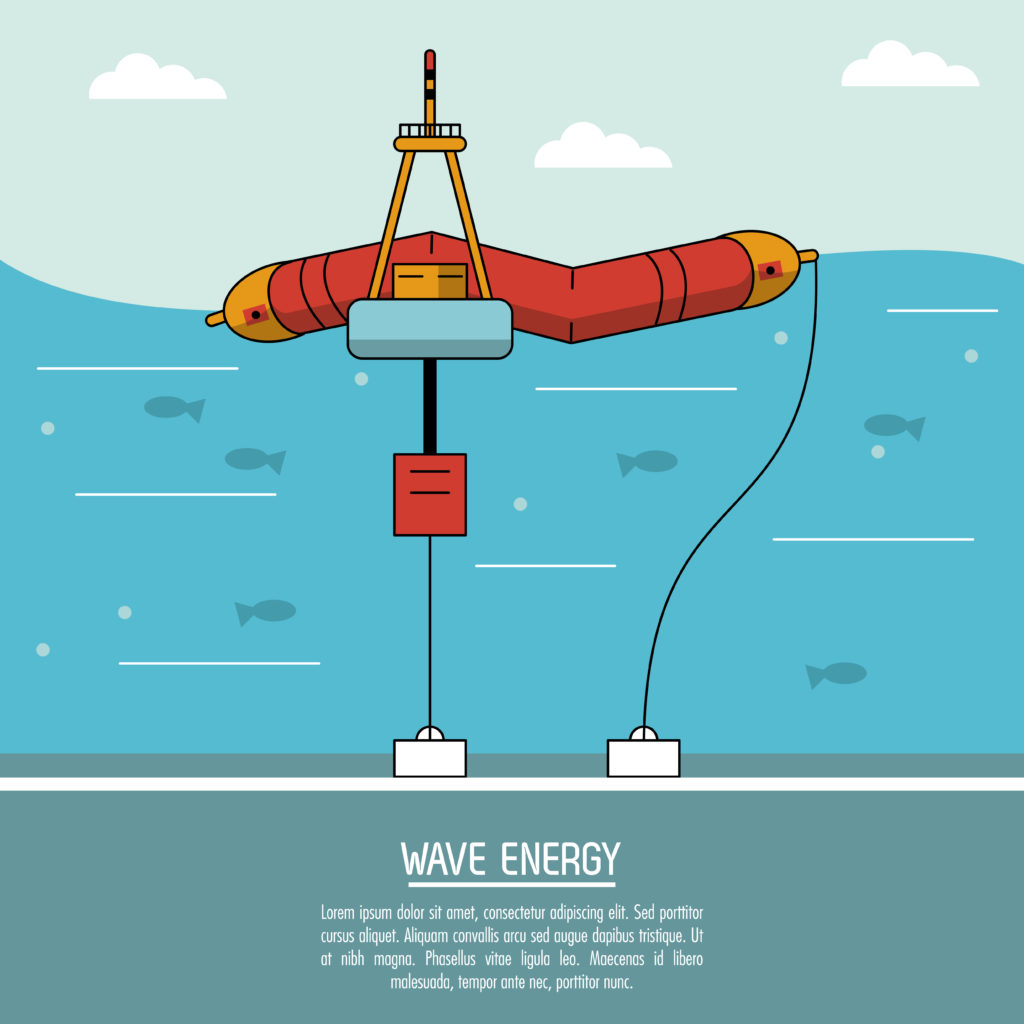Wave power or wave energy is the capture of energy of wind waves for electricity generation, water desalination, or pumping water. A machine that exploits wave power is a wave energy converter (WEC).
Wave Energy Converter
Wave power has been used for centuries by humans to pump water and grind grain. However, it was not until the late 19th century that scientists began to investigate the potential for generating electricity from wave power. In the early 20th century, several patents were filed for various wave power devices, but it was not until the 1970s that research and development really took off.
Wave energy is a very attractive source of renewable energy because it is abundant, predictable, sustainable, and environmentally friendly. In this regard, it is considered a major and upcoming tool in the global fight against climate change. There are many different types of wave energy converters (WECs), but they all work by converting the energy of waves into another form of energy, usually electricity.
Oscillating Water Column
The most common type of WEC is the oscillating water column (OWC). OWCs are typically anchored to the seabed and have a chamber that fills with water as waves pass through. The rise and fall of the water level in the chamber creates a pressure difference that drives an air turbine, which produces electricity.
Other types of WEC include point absorbers, which are floating devices that capture energy from the heaving motion of waves; attenuators, which are long, floating structures that capture energy from the back-and-forth motion of waves; and overtopping devices, which are dams that capture energy from the flow of water over them.
Renewable Energy
Wave energy is a very promising source of renewable energy, but there are still some challenges to commercializing it. One challenge is that wave energy devices need to be able to withstand the harsh conditions of the marine environment, including storms, waves, and salt water. Another challenge is that wave energy is a variable resource, meaning that its output can vary depending on the strength and direction of the waves. This makes it difficult to integrate wave energy into existing power grids.

Costs of Wave Power
The cost of electricity from wave power is currently higher than the cost of electricity from other sources, such as coal or natural gas. However, the costs of wave energy are expected to decrease as technology improves and more experience is gained in operating wave energy farms.
Carbon Offsets
One way to reduce the cost of wave energy is to use it to offset carbon emissions from other sources. For example, a carbon-neutral power plant could be built that generates electricity from both wave energy and fossil fuels. The carbon dioxide emitted by the fossil fuel part of the plant would be offset by the lack of emissions from the wave energy part of the plant. This would result in a power plant that emits no net carbon dioxide, making it much more environmentally friendly than a traditional fossil fuel power plant.
Wave Power in the United States
In the United States, the Department of Energy’s National Renewable Energy Laboratory (NREL) is researching and developing wave energy technologies. NREL’s Wave Energy Converter Usability site (WECU) is testing different types of WECs in a variety of real-world conditions.
The U.S. Navy is also interested in wave energy as a potential source of renewable energy for its operations. The Navy has been working with industry partners to test WEC prototypes at its Wave Energy Test Site (WETS) in Hawaii.
The first commercial wave energy project in the United States is the 10-megawatt (MW) Marine Hydro kinetic (MHK) Project, which is being developed by Ocean Power Technologies off the coast of Oregon.
European Union
The European Union has been a leader in the development of wave energy, with several commercial projects already in operation. The world’s first commercial wave energy farm is the 30-MW Aguçadoura Wave Farm in Portugal, which has been in operation since 2008. Portugal also has a 5-MW wave energy farm off the coast of Pico Island, and plans to build a 100-MW wave farm in Madeira.
Wave Power in Australia
Australia has a long history of using wave power to pump water and grind grain. In more recent years, Australia has become a leader in the development of wave energy, with several projects underway. The most advanced project is the Carnegie Wave Energy Project, which is a 10-MW demonstration project off the coast of Western Australia. The project is using Carnegie’s CETO wave energy technology, which consists of buoys that capture energy from the motion of waves and convert it into electricity.
Another wave energy project in Australia is the Wave Hub, which is a test site for different types of WECs. The Wave Hub is located off the coast of Cornwall in the United Kingdom, and is connected to the grid. Australia also has a number of wave energy research projects underway, including the Australian Renewable Energy Agency (ARENA)-funded Wave Swell Energy Project, which is testing a new type of WEC.
Wave Power in New Zealand
In New Zealand, the Tidal Energy Demonstration Facility (TEDF) is testing different types of WECs. The TEDF is located in the Port of Lyttelton, and is connected to the grid. New Zealand also has a number of wave energy research projects underway, including the ARENA-funded Wave Swell Energy Project, which is testing a new type of WEC.
Wave Power in Canada
In Canada, the Halifax Waterfront Wave Energy Test Facility (HWWEETF) is testing different types of WECs. The HWWEETF is located in Halifax, Nova Scotia, and is connected to the grid.
India
In India, the National Institute of Ocean Technology (NIOT) is researching and developing wave energy technologies. NIOT’s Wave Energy Converter Usability site (WECU) is testing different types of WECs in a variety of real-world conditions. The government of India is also supportive of wave energy, and has provided funding for several projects, including the ARENA-funded Wave Swell Energy Project, which is testing a new type of WEC.
United Kingdom
The United Kingdom has also been active in the development of wave energy, with several projects underway. One project is the Severn Bore tidal power scheme, which would use the natural tides of the River Severn to generate electricity. The United Kingdom has two commercial wave energy farms in operation, the 1.2-MW Wave Hub off the coast of Cornwall and the 4-MW MeyGen project in the Scottish Highlands. The UK is also home to the European Marine Energy Centre (EMEC), which is a test site for wave and tidal energy devices.

